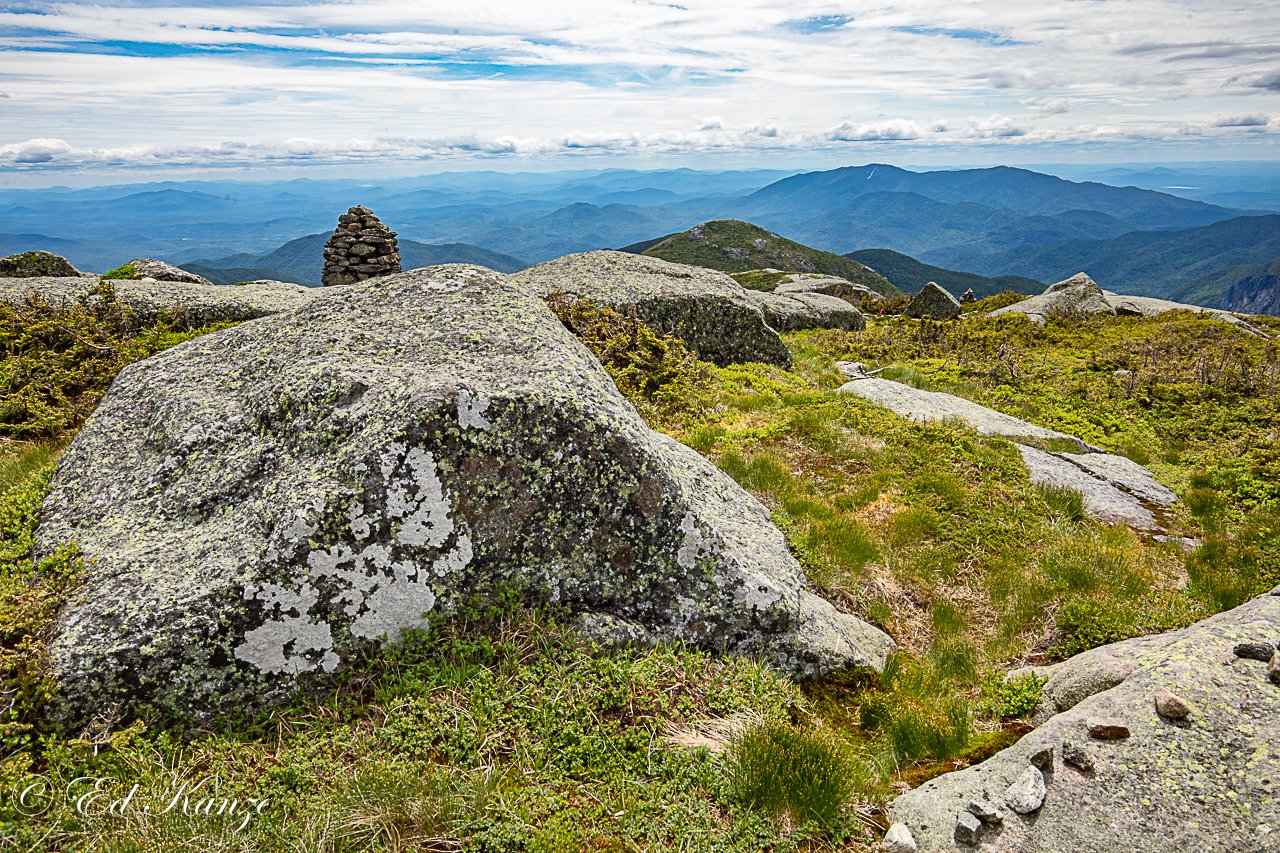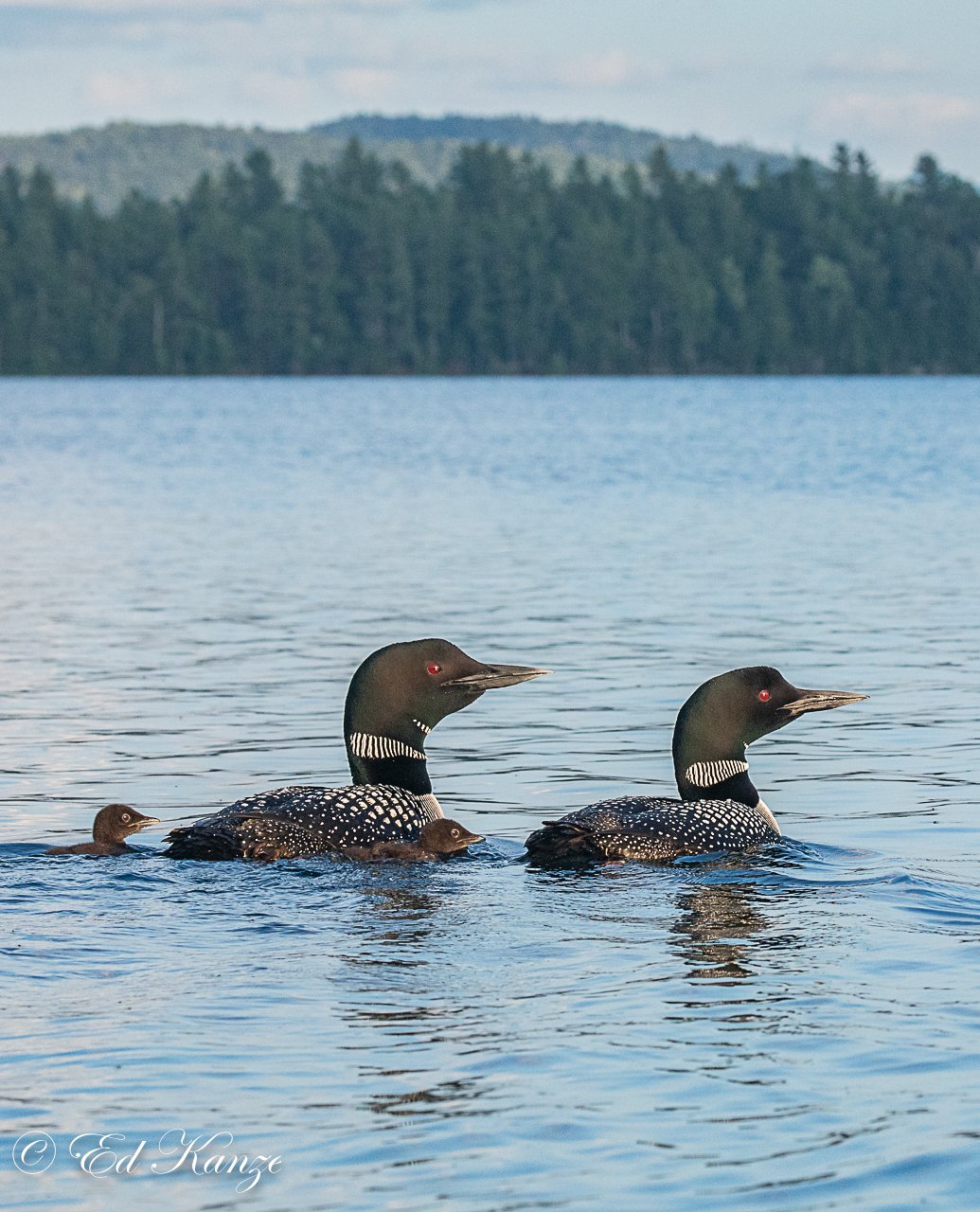Algonquin Peak summit
Nearly a year—-a busy and eventful year—-has passed since I last shared words and images here. Time to do a little catching up! What follows are images collected since my preceding post, along with a few words to go with them. The photo above shows the summit of Algonquin Peak, second highest mountain in the Adirondacks. I climbed it with my son, Ned, in June. Drinking too little water during the hot, steep climb, I felt dizzy and faint near the top, a dramatic reminder about the importance of drinking generous amounts of fluid on the trail.
Mountain sandwort
The wildflower above, flourishing in a crack in the bedrock on the Algonquin summit, is mountain sandwort. Nate Greene, the Summit Steward, was doing a marvelous job of welcoming hikers while reminding them to keep off the hardy but fragile alpine plants and the scant soil they grow in.
View from Hopkins Mountain
Ned and I climbed Hopkins Mountain from a trailhead near Keene Valley in May. This was our first big hike of the summer. The photo immediately below was from our next hike, which followed the Nun-da-ga-o Ridge near Keene. Heavy smoke from Canadian wildfires helped define the ranges.
View from Nun-da-ga-o Ridge
View from Esther Mountain summit to Moose and McKenzie Mountains
Ned and I climbed Esther and Whiteface Mountains one day in July. Canadian wildfire smoke lightly clouded the air. The two high mountains in the view from Esther (above) are McKenzie and Moose. Below is a photo showing the top of Whiteface. Sometimes a late start brings advantages. One for us was having the normally busy summit of Whiteface all to ourselves. The automobile road that ascends most of the way to the summit had closed for the day, and everyone was gone. Another bonus: on the way down through darkening woods, we were serenaded by the swirling, rising, flute-like songs of Swainson’s thrushes. And at one point, I stopped for a rest and found myself surrounded by boreal chickadees.
Hiker Ned Kanze enjoying the Whiteface Mountain summit on a quiet July evening
Ned and I also did some paddling in canoes this summer. Our best trip was a day spent on wild, remote Lake Lila. The first photo below shows Lila from the summit of Mt. Frederica. The second pictures a Lila loon, rearing up in the middle of a splash bath.
Lake Lila from the summit of Mt. Frederica
Common loon on Lake Lila
Speaking of loons, here are additional images of them from summer 2023, shot from a solo kayak.
Common loon pair in misty, smoky light
Common loon staff meeting
Common loon family spending a quiet morning at home
Common loon adult with hatchlings
Common loon carrying a fish to feed one of its young
Loons weren’t the only birds I photographed this year. Here are more.
Female ruby-throated hummingbird visiting a cardinal-flower (I was photographing the flower when the bird showed up)
Great blue heron coming in for a landing at its nest
Three baby flickers poking out of nest hole in a dead American elm
Barn swallow deciding which mouthful of mud to grab for nest-building
Common yellowthroat male in speckled alder
Chestnut-sided warbler male in speckled alder
Chestnut-sided warbler male close-up
Male bobolink on a fencepost
Male boblink
Male red-winged blackbird
Red-eyed vireo portrait
While we’re on a red theme, let’s visit a red fox family I photographed last May. Friends discovered the fox den and kindly granted permission to set up a blind and shoot from their property.
Mother red fox arriving at the den where pups await
Mother red fox nursing her pups
Red fox pups at den
Mother red fox losing her cool as pups run off
Mother fox enjoying a stretch while her offspring pile up in a rumble
Mother fox studying a low-flying airplane
Red fox portrait
Let’s move on to a few “herps,” which in the lingo of naturalists are amphibians and reptiles. Just a few images: an eastern newt found in the wandering juvenile eft stage of its development on Cascade Mountain; two shots of male American toads singing in a pond near our house; two common garter snakes basking on a warm rock at John Dillon Park, near Long Lake; and a timber rattlesnake that Ned and I went looking for on a sunny late May morning on the Lake Champlain side of the Adirondacks. We spent about an hour with the snake, keeping a safe distance from it. The handsome black-and-gold reptile rattled at our approach but relaxed after we showed ourselves harmless. It cruised the forest floor as we followed and eventually disappeared under a bush.
Eastern newt in terrestrial eft stage
American toad male singing
Another American toad male singing
Two common garter snakes basking on a warm rock at John Dillon Park
Timber rattlesnake (black phase)
Let’s wrap up this miscellany of animals with one fish and two insects: a brook trout in murky water, the murk giving the image the feel of a watercolor painting; a spring azure butterfly, feeding on and likely pollinating a wild strawberry flower; and a pair of painted dancer damselflies, intimately coupled.
Brook trout
Spring azure butterfly on wild strawberry flower
Variable dancer damselflies mating at Minnow Pond, Blue Mountain Lake
Before shifting to flowering plants, let’s honor Kingdom Fungi. The wet summer of 2023 made for a fabulous display in the woods of mushrooms and other fungi. Worldwide, one hundred and fifty thousand are fungi have been distinguished and given names, out of an estimated global total of somewhere between 2 and 4 million species. Their tremendous diversity is my weak excuse for knowing only a few of them. I aim to do better in the future. Two mushrooms are pictured here: the much-feared and ominously named destroying angel, among the most poisonous and one that turns up not only in the woods but in schoolyards, on playing fields, and on suburban lawns; and a small orange gilled mushroom, identity unknown. I close out this section with a photograph of a lichen colony. Lichens are compound organisms that include a multicellular fungus, a photobiont (an alga or a cyanobacterium), and one or more yeasts.
Destroying angel mushroom (extremely poisonous)
Handsome but unidentified orange mushrooms (perhaps a kind of waxcap)
A world of lichens in a knot-hole
Our quick tour of recent nature photos winds down with a selection of wild flowering plants, placed here in the order I found them; three images of moving water in a summer where rain fell heavily; and finally, a dramatic sunset at our house, one that occurred in a season rich in dramatic sunsets.
Carolina spring-beauty
Showy ladyslippers (photographed just outside the Adirondack Park)
Sheep laurel
Rose pogonia
Calopogon (Grass Pink) orchid
White-fringed orchid
Common (white) water-lily in pewter-colored light
Turtlehead
Raquette Falls
Chubb River below Wanika Falls
Wanika Falls (middle leap)
Sunset on the Saranac River






















































